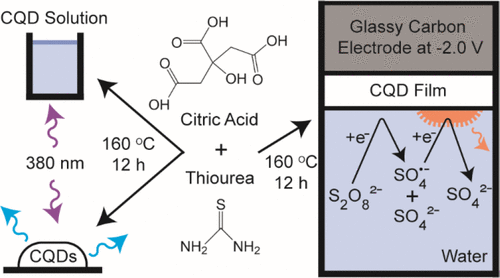Our official English website, www.x-mol.net, welcomes your
feedback! (Note: you will need to create a separate account there.)
Electrochemiluminescence and Photoluminescence of Carbon Quantum Dots Controlled by Aggregation-Induced Emission, Aggregation-Caused Quenching, and Interfacial Reactions
Langmuir ( IF 3.7 ) Pub Date : 2020-11-18 , DOI: 10.1021/acs.langmuir.0c02886 Jonathan Ralph Adsetts 1 , Salena Hoesterey 1 , Chenjun Gao 1 , David A. Love 2 , Zhifeng Ding 1
Langmuir ( IF 3.7 ) Pub Date : 2020-11-18 , DOI: 10.1021/acs.langmuir.0c02886 Jonathan Ralph Adsetts 1 , Salena Hoesterey 1 , Chenjun Gao 1 , David A. Love 2 , Zhifeng Ding 1
Affiliation

|
Carbon quantum dots (CQDs) show promise in optoelectronics as a light emitter due to simple synthesis, biocompatibility and strong tunable light emissions. However, CQDs commonly suffer from aggregation caused quenching (ACQ), inhibiting the full potential of these light emitters. Studies into different ideal light emitters have shown enhancements when converting common ACQ effects to aggregation induced emission (AIE) effects. We report CQD synthesis using citric acid and high/low thiourea concentrations, or sample 2/1. These two CQDs exhibited AIE and ACQ PL effects, respectively. CQD characterizations and photoluminescence interrogations of CQD films and solutions revealed that these unique emission mechanisms likely arose from different S incorporations into the CQDs. Furthermore, it was discovered that sample 2 emitted electrochemiluminescence (ECL) more intensely than sample 1 in a homogenous solution with S2O82– as a coreactant, due to aggregation and interactions of CQD species in solution. Very interestingly, sample 1’s CQD film|S2O82– system achieved an ECL efficiency of 26% and emitted roughly 26 times more efficiently than sample 2 in the same conditions. Predominant interfacial reactions and surface state emission produced intense white light with a correlated color temperature of 2000 K. Spooling ECL spectroscopy was utilized to investigate emission mechanisms. Sample 2’s CQD film|TPrA system had four times higher ECL intensity than that of sample 1, most likely due to π-cation interactions leading to a strong CQD•+ stability, thereby, enhancing ECL. It is anticipated that ECL enhancement of CQD films or solutions by means of AIE will lead to wide CQD optoelectronic applications.
中文翻译:

聚集诱导的发射,聚集引起的猝灭和界面反应控制的碳量子点的电化学发光和光致发光
碳量子点(CQD)由于简单的合成,生物相容性和强大的可调光发射而在光电子领域显示出广阔的前景。但是,CQD通常遭受聚集引起的猝灭(ACQ),从而抑制了这些发光体的全部电势。对不同的理想发光器的研究表明,将常见的ACQ效果转换为聚集诱导发射(AIE)效果时,增强了。我们报告了使用柠檬酸和高/低硫脲浓度或样品2/1进行CQD合成。这两个CQD分别显示AIE和ACQ PL效果。CQD薄膜和溶液的CQD表征和光致发光研究表明,这些独特的发射机制可能是由不同的S掺入CQD引起的。此外,2 O 8 2 –作为共反应物,由于溶液中CQD物质的聚集和相互作用。非常有趣的是,在相同条件下,样品1的CQD膜| S 2 O 8 2-的ECL效率达到26%,发射效率比样品2高出约26倍。主要的界面反应和表面态发射产生了强烈的白光,相关色温为2000K。缓冲ECL光谱用于研究发射机理。样品2的CQD膜| TPrA系统的ECL强度是样品1的四倍,这很可能是由于π阳离子相互作用导致CQD强•稳定性,从而增强了ECL。预期通过AIE增强CQD薄膜或解决方案的ECL将导致CQD光电应用广泛。
更新日期:2020-12-01
中文翻译:

聚集诱导的发射,聚集引起的猝灭和界面反应控制的碳量子点的电化学发光和光致发光
碳量子点(CQD)由于简单的合成,生物相容性和强大的可调光发射而在光电子领域显示出广阔的前景。但是,CQD通常遭受聚集引起的猝灭(ACQ),从而抑制了这些发光体的全部电势。对不同的理想发光器的研究表明,将常见的ACQ效果转换为聚集诱导发射(AIE)效果时,增强了。我们报告了使用柠檬酸和高/低硫脲浓度或样品2/1进行CQD合成。这两个CQD分别显示AIE和ACQ PL效果。CQD薄膜和溶液的CQD表征和光致发光研究表明,这些独特的发射机制可能是由不同的S掺入CQD引起的。此外,2 O 8 2 –作为共反应物,由于溶液中CQD物质的聚集和相互作用。非常有趣的是,在相同条件下,样品1的CQD膜| S 2 O 8 2-的ECL效率达到26%,发射效率比样品2高出约26倍。主要的界面反应和表面态发射产生了强烈的白光,相关色温为2000K。缓冲ECL光谱用于研究发射机理。样品2的CQD膜| TPrA系统的ECL强度是样品1的四倍,这很可能是由于π阳离子相互作用导致CQD强•稳定性,从而增强了ECL。预期通过AIE增强CQD薄膜或解决方案的ECL将导致CQD光电应用广泛。















































 京公网安备 11010802027423号
京公网安备 11010802027423号